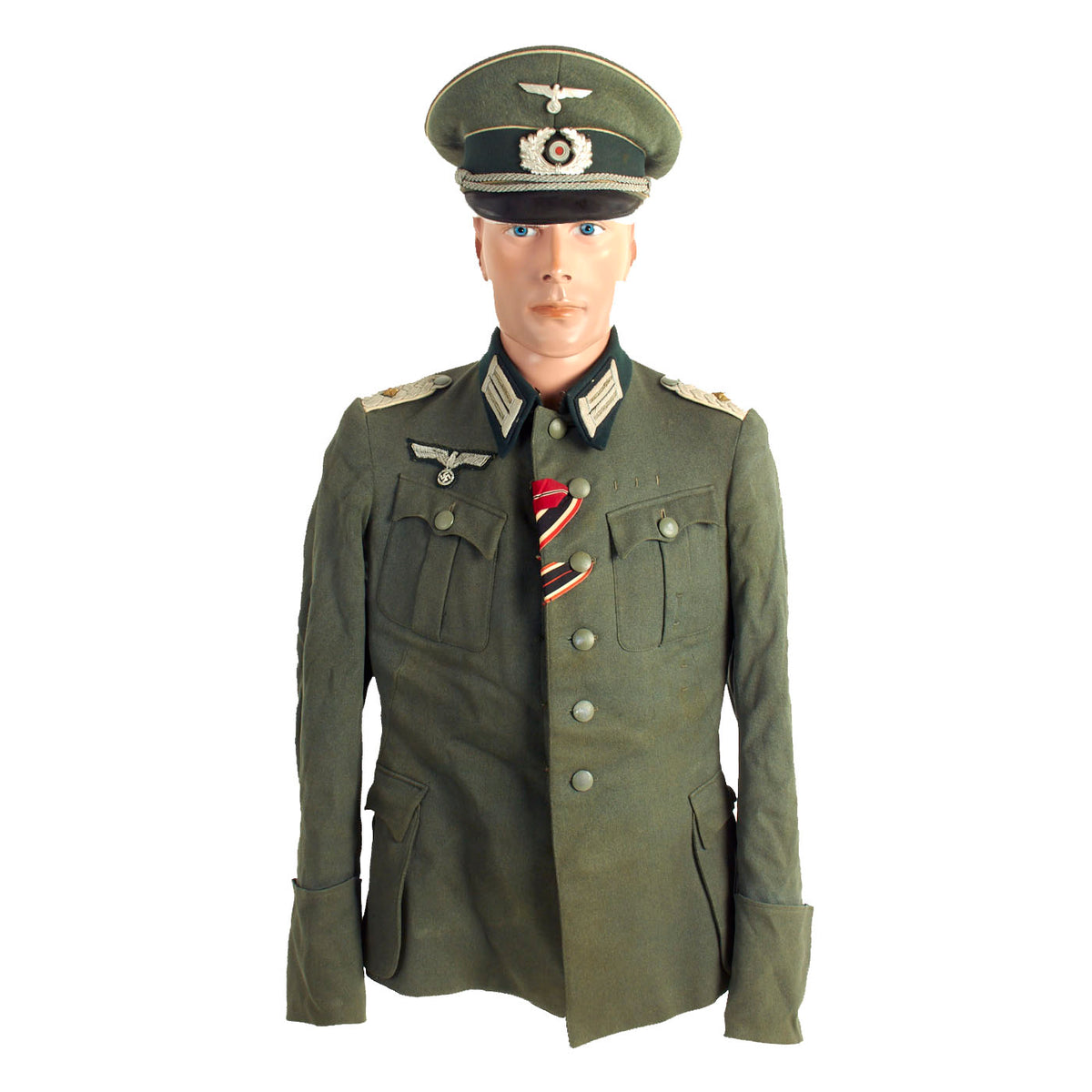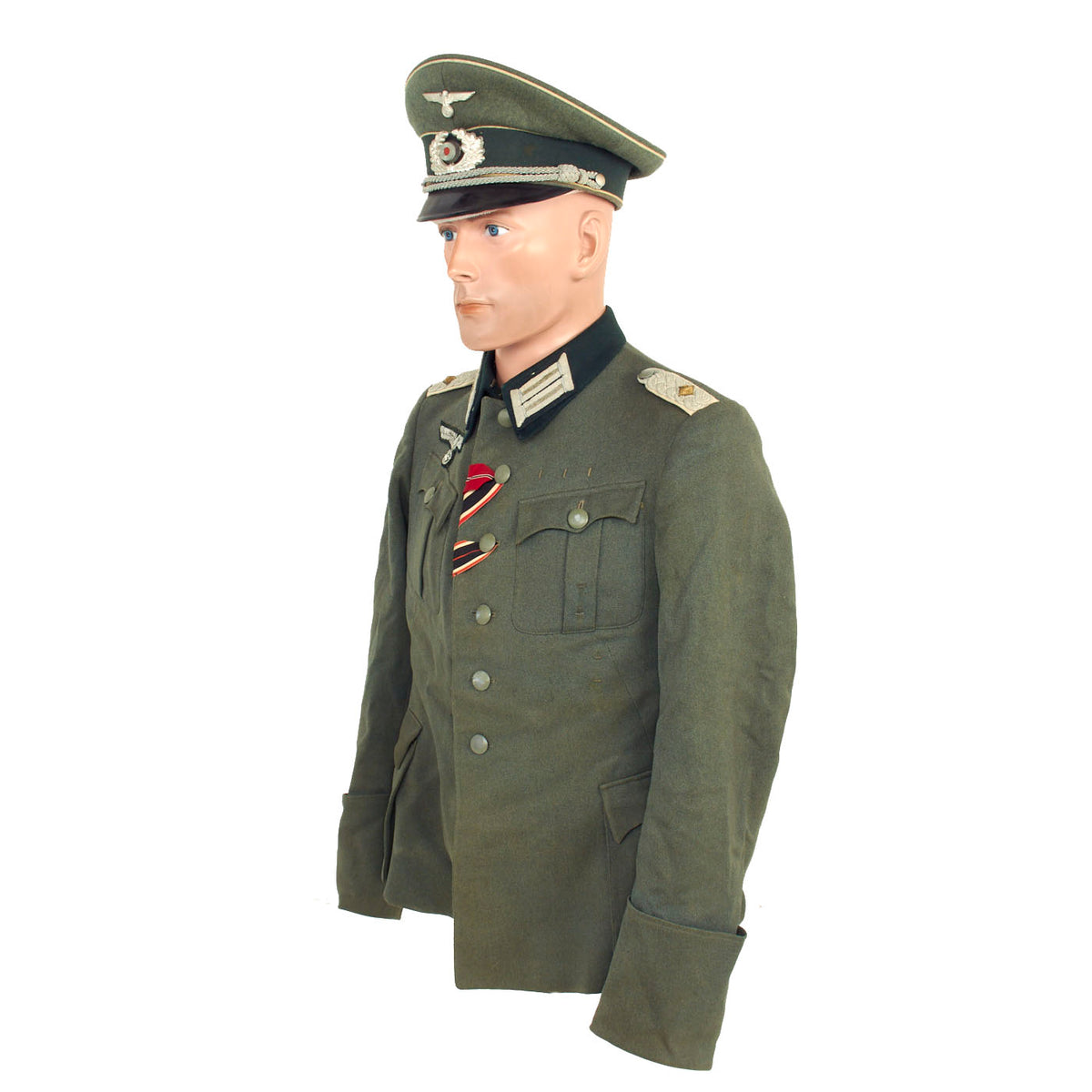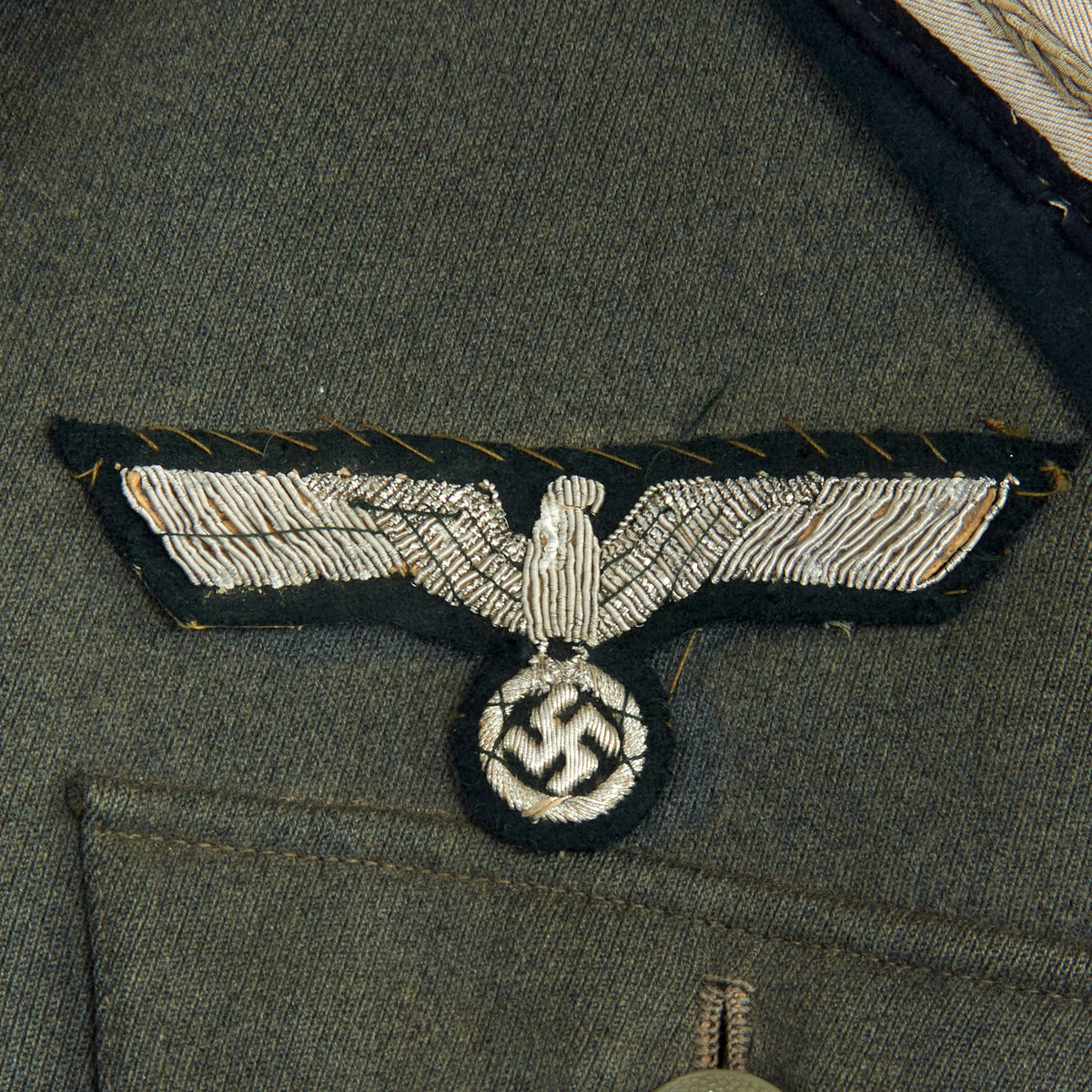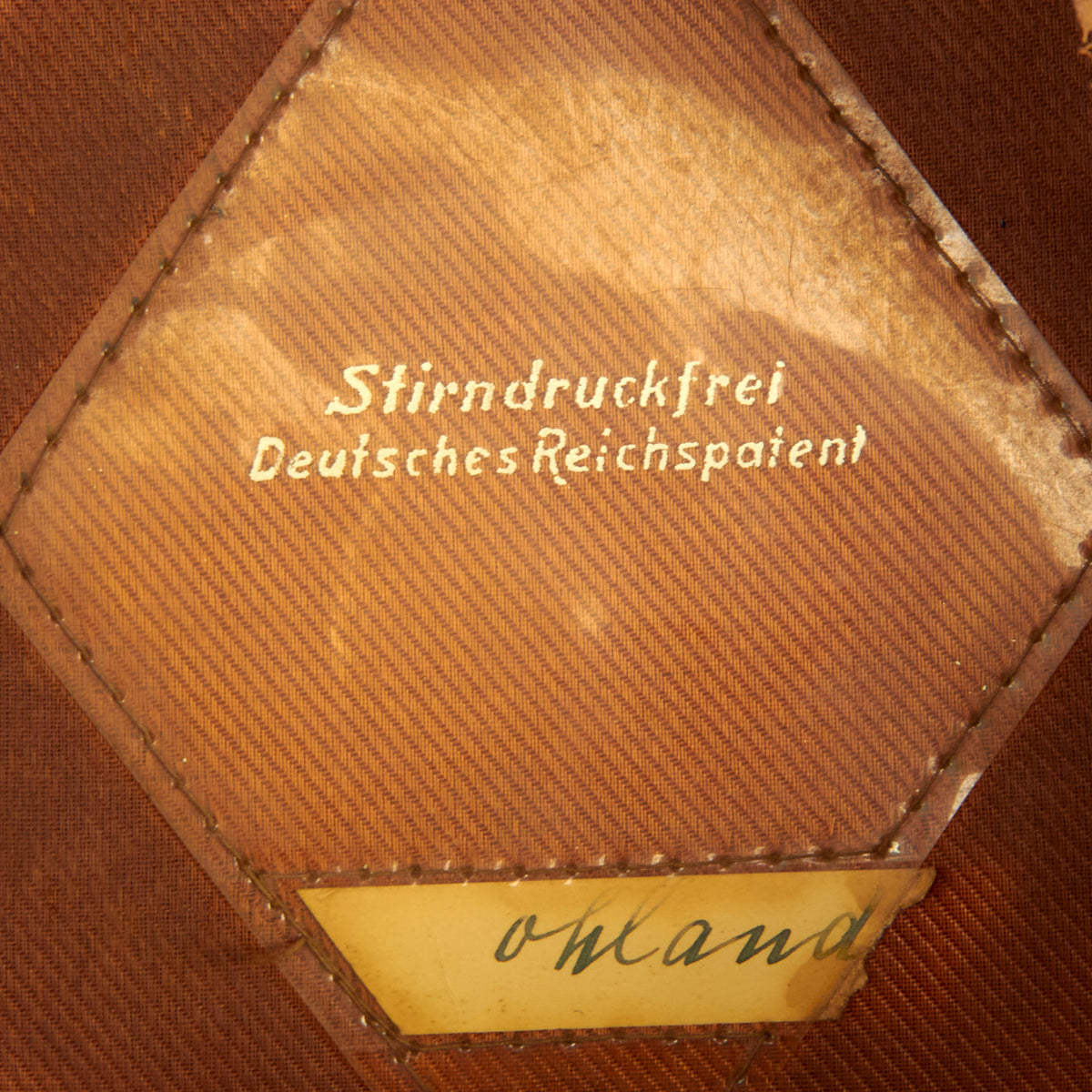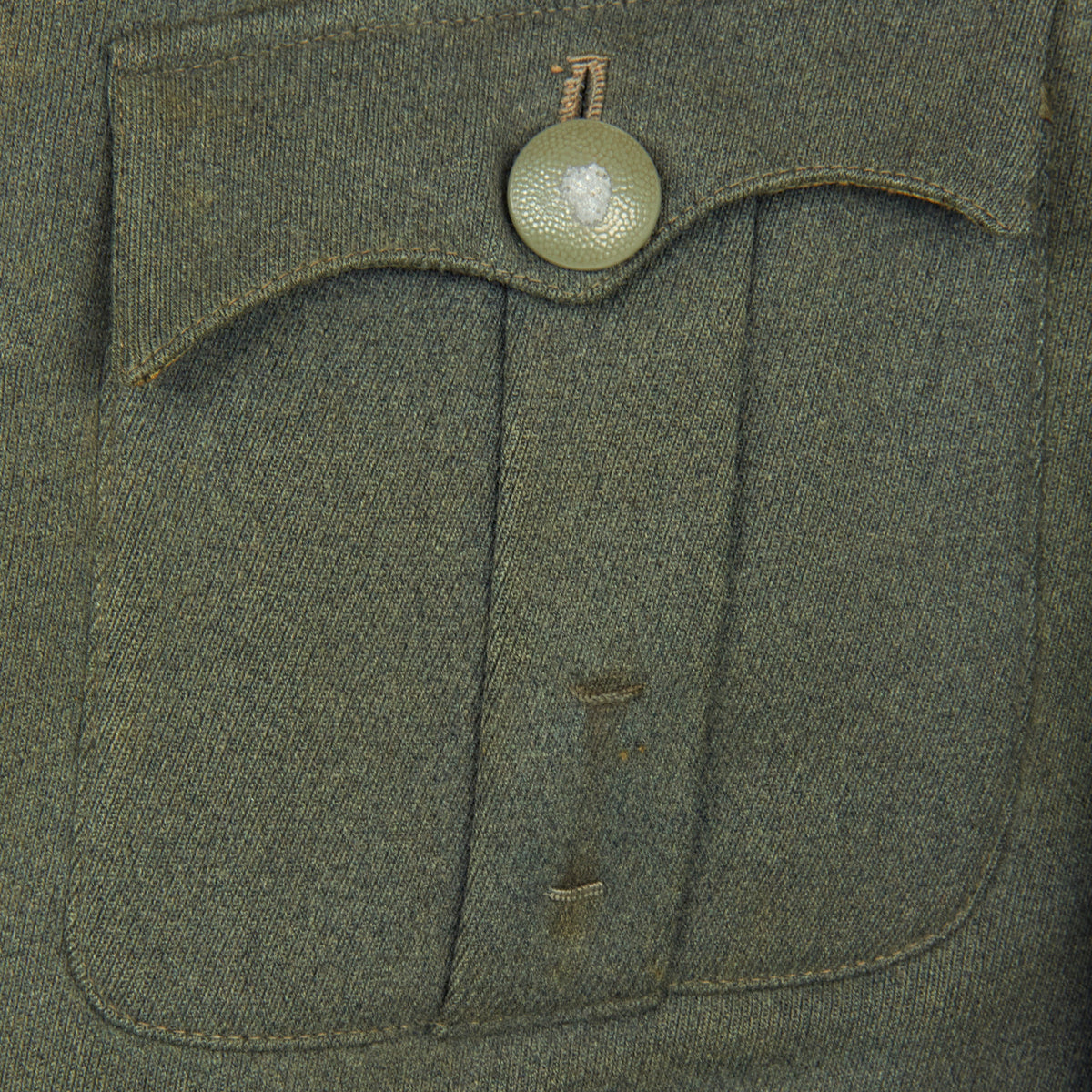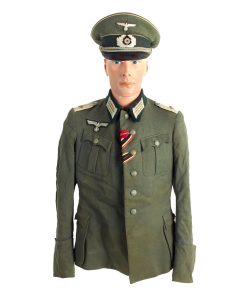Original German WWII Heer Army Matching Named Infantry Oberstleutnant Officer’s M36 Field Tunic & Schirmmütze Visor Cap Set Original Items
$ 2.395,00 $ 598,75
Original Items: One-of-a-Kind Set. This is a fantastic USGI bring back set, purchased at a recent military show after being recently found in a U.S. Serviceman’s trunk by his family. It is a matching named set of a German WWII Officer’s M36 Field Tunic and Schirmmütze visor cap. The tunic still has the original maker tag inside the left interior pocket, printed with handwritten particulars, that reads:
Josef Wenko, Hofschneider
Regensburg, Schlossergasse 4
Herr Leutnant Ohland
den 26. Juni 1936
Additionally, there is a small name tag inside the celluloid diamond of the visor cap, reading Ohland. It is very rare that we get matching named sets like this, full of both display and research potential!
The included tunic is a very nice early war pattern German WWII Heer Army Infantry Stabsoffiziere (Staff Officer) M-36 Field Tunic, showing some service wear and in nice untouched condition. Given the age of the Tunic, Ohland wore this for quite some time, through promotions he received over the years.
It is adorned with the usual rank and branch insignia used on German tunics. The attractive Army breast eagle is the correct officer’s silver bullion hand embroidered type on a green background, and is very neatly hand stitched to the chest in a fashion typical of wartime German tailor work. The second buttonhole from the top on the tunic has the ribbons for a War Merit Cross (KVK) and Eastern Front medal installed. The buttonhole below this has the ribbon for the War Merit Medal. There are also some thread loops on the pocket underneath, so there are awards that the German soldier removed, probably to put on another uniform, as well as loops above for a medal ribbon bar.
The tunic features four pockets with scalloped flaps and pebbled aluminum buttons, and is closed with six painted pebbled aluminum buttons on the right breast flap meeting an equal number of reinforced buttonholes on the left flap. It should be noted that the buttons except for the top one have all been moved 4 cm closer to the button holes to increase the size of the tunic. This could have been due to the officer needing a larger size, but was more often due to the need for wearing insulated clothing underneath. As Ohland received the Eastern Front Medal, aka the “Frozen Meat Medal”, he would have needed it. All buttons are maker marked on the reverse, though this can be hard to see due to oxidation. The interior of the tunic is lined with a green / gray cotton rayon blend, which is well retained. There are some repairs and stains, but overall it is very nice.
The collar is wrapped in a dark-green wool, has officer’s field litzen collar patches on each side, which are woven from silver bullion thread with a dark green background matching the collar. The colored stripes on each are a faded Weiß (white), the Corps Color (Waffenfarbe) for infantry and motorized infantry. Unfortunately the bullion piping would have the color wear away over time, as on this example. The “sew-in” style Stabsoffizier schulterklappen (Field-grade Officer shoulder boards) of this tunic are constructed with two rows of fine silver flatware “Russia Braid” double piping, which are plaited together to form a loop around the buttonhole. They are in very good condition, both have the correct white infantry felt base. Each also has single rank “pip” installed, indicating the staff officer rank of Oberstleutnant, equivalent to the rank of Lt. Colonel the U.S. and U.K. armies.
This cap in the set is an excellent condition example of a German WWII Wehrmacht Heer Army Officer Schirmmütze visor cap. It features the typical felgrau (field gray) wool gabardine construction with a forest green “badge cloth” band and a traditional high forward crown. The also has matching Weiß (white) piping along the top edge and flanking either side of the band. This is the Waffenfarbe (Corps Color) for the Infanterie (Infantry) and Motorisiert Infanterie (Motorized Infantry). It has the correct bullion chin strap, indicating that it is for an officer. The crown stiffener is still present, so the original shape is well retained, though it does have a bit of the “saddle form” shape everyone loves.
It is decorated with a well detailed aluminum eagle insignia on the peak and an open silvered aluminum wreath surrounding a tri-color cockade on the band. The cockade still retains the bright red felt center inlay, and the silvering on the insignia is all in fantastic condition. The chin strap is attached with the standard pebbled silvered buttons on either side of the cap. The vulcanfibre visor has a smooth black leather-look upper, and is brown on the underside. The oilcloth sweatband has unfortunately deteriorated quite a bit over the years, and has almost completely torn away from the cap, showing the underlying structure. This is definitely a cap that saw significant wear.
The cap is lined with lovely brown rayon faux silk, and still retains the full celluloid diamond sweat shield in the crown, which has the owners name in the slot. There is no maker name present, just Stirndruckfrei Deutsches Reichspatent, which translates to “Forehead Pressure Free – Patented”. Overall exterior condition is simply great, with a fantastic look. Most likely this is not the first visor cap that Ohland owned, and is a later war replacement for his original.
Condition of the set overall is very nice, showing a well cared for slightly customized tunic and a really nice visor cap. This is an officer that saw long service and definitely cared for his equipment. There is definitely wear, but that means that these items had “really been there” during the war, and were not just items found in depots post war.
This is really a fantastic one of a kind set, full of display and research potential. We rarely get sets with evidence of such long service, with everything correct and in good shape. This is sure to make a great addition to any WWII Collection!
Approx. Measurements:
Collar to shoulder: 9″
Shoulder to sleeve: 25.5”
Shoulder to shoulder: 14”
Chest width: 17.5”
Waist width: 17.5″
Hip width: 20”
Front length: 28″
Terms such as M40 and M43 were never designated by the Wehrmacht, but are names given to the different versions of the Model 1936 field tunic by modern collectors, to discern between variations, as the M36 was steadily simplified and tweaked due to production time problems and combat experience.
Field Tunic (Feldbluse) Model 1936
When the NSDAP came to power in early 1933 the Reichswehr, the armed forces of the Weimar Republic, were near the end of a two-year project to redesign the Army Feldbluse (field-blouse). Beginning in that year the new tunic was issued to the Reichsheer and then the rapidly growing Wehrmacht Heer, although minor design changes continued to be made until the appearance of the standardized Heeres Dienstanzug Modell 1936. The M36 tunic still retained the traditional Imperial and Reichswehr uniform color of grey-green “field gray” (feldgrau) wool, but incorporated four front patch pockets with scalloped flaps and pleats (on Reichswehr tunics the lower pockets were internal and angled). The front was closed with five buttons rather than the previous eight, and the collar and shoulder straps were of a dark bottle-green instead of the Reichswehr grey. Compared to the Weimar-era uniforms the skirt of the feldbluse was shorter and the tailoring was more form-fitting due to Germany’s adoption of mechanized warfare: soldiers now spent much time in the confined space of a vehicle and a shorter jacket was less likely to pick up dirt from the seats. It also included an internal suspension system, whereby a soldier could hang an equipment belt on a series of hooks outside of the tunic. These hooks were connected to two straps inside the lining, which spread the weight of equipment without having to use external equipment suspenders. The M36 was produced and issued until the very end of the war, though successive patterns became predominant.
The German Schirmmütze Visor Cap:
The visor cap (Schirmmütze) was an important part of the headgear worn by German uniformed military, civil, paramilitary and political organizations during the Third Reich. This was the standard cloth headgear worn as a part of the service uniform. Visor caps were worn outdoors as well as indoors, and were often required to be worn by all personnel on duty. Visor caps were made in versions specific to each organization and were often further differentiated through the use of insignia, colored piping, or style of chin cord, to indicate rank, role or branch. The insignia used on these caps ranged from simple stamped metal emblems, to elaborate hand embroidery. Visor caps were issued to enlisted soldiers and NCOs in the military and in some other organizations. Officers had to purchase their own hats, and lower ranks could choose to purchase caps that were of a higher quality than the rather basic, issue examples. The private purchase caps were generally made in very high quality, with fine materials. A wide variety of fabrics were used, from Trikot and doeskin, to heavy wool, or even lightweight white fabric for summer wear. In the military, issue of these caps was generally suspended shortly after the outbreak of the war, but they continued to be worn by some troops until the end of the war.
Fast Shipping with Professional Packaging
Thanks to our longstanding association with UPS FedEx DHL, and other major international carriers, we are able to provide a range of shipping options. Our warehouse staff is expertly trained and will wrap your products according to our exact and precise specifications. Prior to shipping, your goods will be thoroughly examined and securely secured. We ship to thousands clients each day across multiple countries. This shows how we're dedicated to be the largest retailer on the internet. Warehouses and distribution centres can be located throughout Europe as well as the USA.
Note: Orders with more than one item will be assigned a processing date depending on the item.
Before shipping before shipping, we'll conduct a thorough inspection of the items you have ordered. Today, the majority of orders will be delivered within 48 hours. The delivery time will be between 3-7 days.
Returns
The stock is dynamic and we cannot completely manage it because multiple stakeholders are involved, including our factory and warehouse. So the actual stock may alter at any time. It's possible that you may not receive your order once the order has been made.
Our policy is valid for a period of 30 days. If you don't receive the product within 30 days, we are not able to issue a refund or an exchange.
You can only return an item if it is unused and in the same state as the day you received it. You must have the item in its original packaging.
Related products
Uncategorized
Angolan Rebel 1970s era 60mm Inert Display Mortar from Angolan Civil War Original Items
Uncategorized
Uncategorized
Uncategorized
Uncategorized
Uncategorized
Uncategorized
Uncategorized
Uncategorized
Armored Burgonet Helmet & Polearm from Scottish Castle Leith Hall Circa 1700 Original Items
Uncategorized
Uncategorized
Uncategorized
Uncategorized
Uncategorized
Uncategorized
Uncategorized
Uncategorized
Uncategorized
Armoured Fighting Vehicles of the World: AFVs of World War One (Hardcover Book) New Made Items
Uncategorized
Australian WWII Owen MK1 Machine Carbine SMG Custom Fabricated Replica with Sling Original Items
